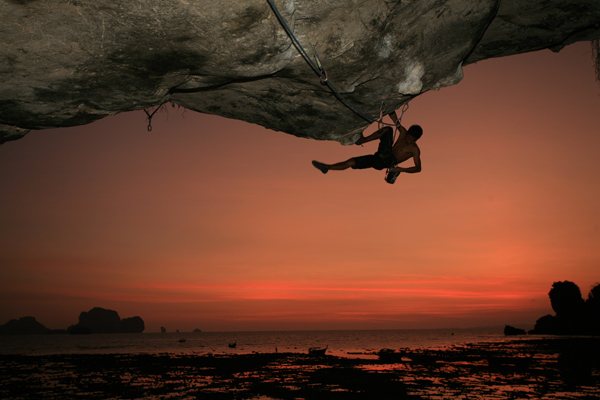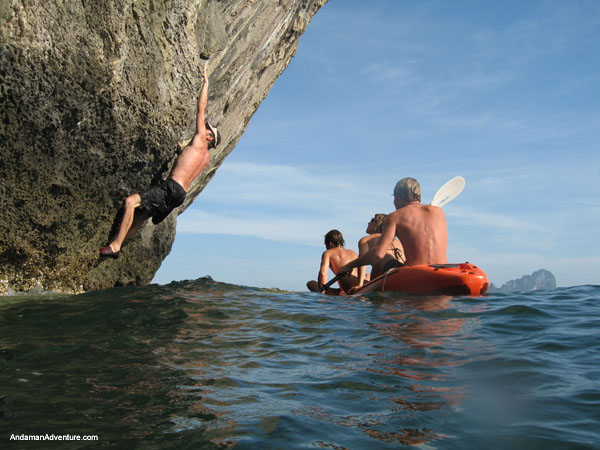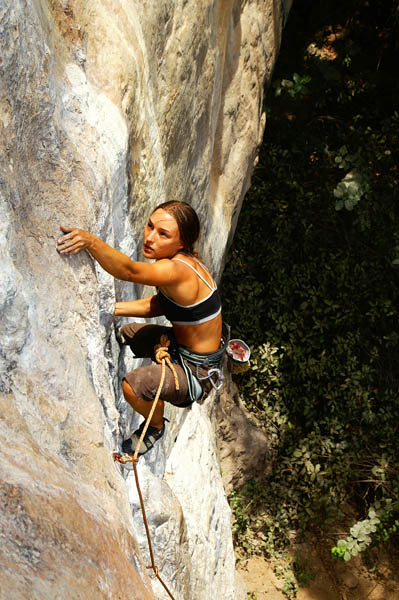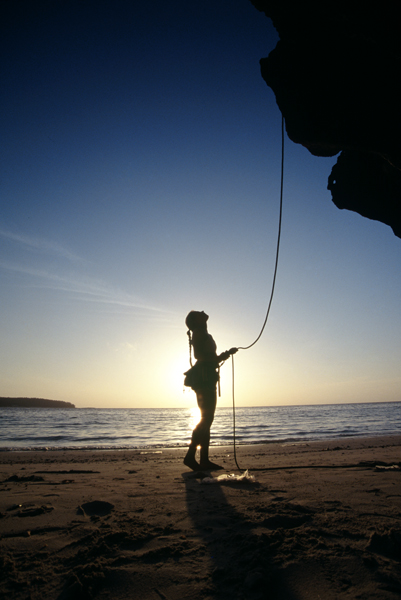Written by Naomi Boman and Simon Ramsden
If a body falls 22 metres under gravity, reaching a terminal velocity of approximately 6.3 metres per second, what is the result? In my case it was a fractured hip, large haematoma and a laceration that needed stitches. The cause of the accident? My belayer took her hands off the rope (a belayer is someone who stands on the ground and secures the climber by paying the rope in and out through a small metal rope-braking device).
Climbing is perfectly safe, it’s just some of the people who climb who are potentially lethal. Vacation time, warm weather, cool people and a relaxed atmosphere all lull visitors into taking risks they would walk away from at home. No, this paragraph is not about safe sex, it’s about climbing risks. In both cases the level of risk depends directly on your choice of partner, who in the climbing scene poses without doubt a greater potential risk to your health than anything else.

I’ve personally seen climbers skip clipping bolts altogether, risking a drop to the ground if a hold breaks or something unforeseen happens. It was my belayer taking her hands off the rope that caused me to hit the ground from seventy feet up and just pure luck that I’m still around today. We once had to confiscate a bottle of whisky from a customer, who was groggily swigging on it
while belaying someone!
The vast majority of climbers do not wear helmets, with some justification, as most of the routes here are climbed thousands of times a year and thus do not suffer from loose rock. Note that it's the belayer who needs the helmet, not the climber - any rocks knocked off will hit the belayer, not the leader. When belaying a top-roper, keep well away from the path of any potential rock-fall. When belaying a leader, follow this advice:
Human error is a fact of life and even very experienced climbers make mistakes occasionally. I heard my name called out at the cliff earlier this year and looked up to see a climber friend of fourteen years’ experience dangling at the end of his rope, thirty metres off the ground. He’d abseiled off from a multipitch (high) route but had forgotten to clip the rope to the rock-face as he descended, so losing contact with the wall and ending up dangling in thin air.
Unfortunately he was in unnecessary danger as he’d forgotten to tie a knot in the end of the rope before beginning his abseil. This would have made it physically impossible for him to lower off the end of the rope, which is a common cause of climbing accidents, usually fatal ones. My friend’s dilemma was thankfully relatively easily resolved with a successful lassoo rescue and a lot of shouting. He later told me that he had been so scared, when dangling at the end of his rope, that the hand that was holding the rope (and was the only thing between him and certain death) started to shake nvoluntarily. He had had to grab the hand with the other hand to calm down the spasms.
Another accident I heard about was due to a rope stretching under tension. The climber slipped when sixty feet up, twenty feet above the last rock-face bolt he had attached the rope to. He was attempting to attach the rope to the anchor, a metal ring attached to the rock-face by rope and three bolts. Rope stretch brought him back to the ground and then on to the mortuary. It doesn’t seem very sensible to be 20 feet above your last bolt unless you fancy a bit of free-soloing practice.
While belaying a climbing partner recently, a friend of mine was given an urgent and pained command to ‘take’ (to grab the rope and take the leader’s weight on it). The leader had put her hand into a crack and been bitten by the biggest, hairiest spider she’d ever seen– which can be a big deal in Thailand.
Some months earlier I’d not noticed a snake eating a bird next to the anchor of my route, but had almost stepped on its friend on the descent. If you want to climb in the jungle, you must expect wildlife. Monkeys have got to be the most unfriendly and overrated creatures around. They have seriously warped value systems. I mean, if you smile at them they will likely assume that you’re baring your teeth preparatory to a fight and will then probably lob something indescribable at you. Such missiles can be impossible to dodge when you are hanging on to a rock-face and they can really ruin your route.
Be aware that abseiling on a single wet rope using anything other than a device designed specifically for the purpose is asking for disaster. A standard eight or ATC won't work properly and you will plummet groundwards at high speed. If you don't have a prussic backup to slow you down, a high-speed ground fall is possible. Whenever abseiling, you should use a prussic backup - if you don't know what one is, find out !
It seems such an obvious safety tip that it's hardly worth mentioning, but somebody died on Railay in 2009 from getting this one wrong. When you tie onto the rope, there are 2 acceptable ways of doing so (a) you tie a knot directly onto your harness (b) you tie a knot onto a locking carabiner, then attach the carabiner to your harness. In 2009 a climber used a quickdraw, instead of a locking carabiner, to attach the rope to his harness. When he got to the top of the climb his belayer took in the tension, then the climber leant backwards on the rope. His quickdraw got tangled up in the rope. The rope forced one of the quickdraw's gates open, and the climber fell and died. such tragedies are so unneccessary.
When your leader comes down and it's your turn to climb, make sure you tie on to the correct end of the rope, which is the one which runs through all the quickdraws before reaching the anchor. Tying onto the wrong end can be dangerous. On a climb where the anchor is above and to either side of the start point, you could have a problem. If you clip into the end of the rope which goes straight to the anchor, then fall off, you risk a dangerous pendulum swing, at the end of which you could hit something hard.
Heres's one last safety tip. It's not common practice in Thailand to tie a knot in the bottom of the rope (ie the end that's not attached to the climber). This is fine when the climber is top-roping. When the climber is leading what most people do in Thailand is make an assessment which goes something like this:
Unfortunately this common practice isn't good enough. What is the leader mistakenly goes off-route and climbs a higher anchor than expected? In this case the rope will not be long enough to lower him to the ground and, if the belayer isn't very careful, the leader will fall. The best practice is to always tie a knot in the bottom of the rope when belaying a leader, no matter how long the rope or high the anchor. It should be one of those automatic checks (like checking your knot).
Climbing can and should be extremely safe, without losing any of the enjoyment or the adrenaline rush. Whether you ‘go Dutch’ and wear a helmet, using your head will take you a long way. After my 22 metre fall I was back at the cliff nine weeks after leaving hospital.
Although my rock gymnastic attempts weren’t much to write home about, I stand by my belief that with good preparation and common sense, rock climbing is safe and should be tried by everyone. After all, it’s as scary and dangerous as you want to make it sound, once you’re safely on the ground and telling your non-climbing friends all about it.





No comments:
Post a Comment